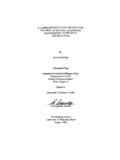Transcription of Classroom Management, Bullying, and Teacher Practices
1 Classroom management , bullying , and Teacher Practices Kathleen P. Allen University of Rochester Abstract While bullying in schools has begun to receive attention, little is known about the relationship between Classroom management and bullying in the Classroom . The process for exploring this relationship will be a review of research and literature related to bullying in the school environment, Classroom management , Teacher Practices , and student behavior. Research from a number of fields suggests that several variables conspire to create environments where bullying is more likely to occur.
2 These include harsh and punitive discipline methods, lower-quality Classroom instruction, disorganized Classroom and school settings, and student social structures characterized by antisocial behaviors. Future directions indicate a need for preservice and in-service education on Classroom management Practices and student bullying . Additionally, future research should consider an investigation of the relationship between Classroom management Practices and student bullying , as well as further exploration of Teacher bullying of students and student bullying of teachers. Introduction Teaching can be a daunting endeavor for both experts and novice teachers.
3 It is a profession that requires the ability to be responsive to new demands and changing needs. In recent years, school reform promoting high-stakes testing in the name of improving academic achievement has dominated the list of problems demanding consideration. However, there are other problems that also demand attention for example, bullying . Although not a new problem, attention to bullying was limited until the events at Columbine High School in April, 1999. In recent years, research has implicated teasing, harassment, and bullying in a number of the targeted school shootings that have taken place in the United States (Vossekuil, Fein, Reddy, Borum, & Modzeleski, 2002).
4 Data indicate that bullying is embedded in a larger problem of school violence. There is another perhaps related issue that has received less attention but is nevertheless a concern for educators: Classroom management . Research over the past few decades has consistently indicated that new teachers feel unprepared when it comes to Classroom management skills (Duck, 2007; Freiberg, 2002; Meister & Melnick, 2003; Merrett & Wheldall, 1993; Stoughton, 2007) and that they are often unprepared to function successfully in today's classrooms with regard to managing administrative tasks, curriculum, and behavior problems (Allen & Blackston, 2003; Bauman & Del Rio, 2006; Kirkpatrick, Lincoln, & Morrow, 2006.)
5 Public Agenda, 2004; Thompson & Walter, 1998). Additionally, it is a well-established fact that student misbehavior is a factor in Teacher burnout and the decision of novice teachers to leave the profession (Public Agenda, 2004). It seems that the need for successful Classroom management skills has not diminished during a time when school reform has put the spotlight on academic testing and student achievement. Thus, it is important to ask the following questions: What is the nature of bullying in the Classroom ? How is it manifested? Is there a connection between school bullying in the Volume 34, No.
6 1 Spring, 2010. Kathleen P. Allen Classroom and Classroom management ? If so, what is it? Would it be beneficial to consider these two issues together? How do teachers learn Classroom management skills? How do they learn about bullying ? When and where does learning about these two issues intersect? Through a review of research literature related to bullying in the school environment, the purpose of this paper is to explore the relationships between Classroom bullying , Classroom management , and Teacher Practices . Theoretical Framework This review of research approaches the issues of Classroom management , bullying in the Classroom , and Teacher Practices from a social-ecological perspective.
7 Swearer and Espelage (2004) note that Bronfenbrenner (1979) described ecological-systems theory as purporting that all individuals are part of interrelated systems that locate the individual at the center and move out from the center to include all systems that affect the individual (p. 3). Drawing upon Bronfenbrenner's ecological-systems theory (1979), Swearer and Espelage argue that bullying has to be understood across individual, family, peer, school, and community contexts (p. 1). Adopting this perspective assumes that the relationships of students to one another and the Teacher within classrooms are reciprocal and interconnected.
8 In other words, the actions of all members of the Classroom affect the behaviors of everyone in that environment, creating a dynamic context and culture. Classroom management What Is Classroom management ? A narrow view of Classroom management sees it primarily as discipline and management of student misbehavior. However, successful teaching requires more than controlling student behavior. According to Evertson and Harris (1999), the meaning of the term Classroom management has changed from describing discipline Practices and behavioral interventions to serving as a more holistic descriptor of teachers' actions in orchestrating supportive learning environments and building community (p.)
9 60). Brophy (1999) echoed those sentiments when he stated that the most successful teachers approach management as a process of establishing and maintaining effective learning environments (p. 44). Finally, Larrivee (2005) noted that Classroom management is a critical ingredient in the three-way mix of effective teaching strategies, which includes meaningful content, powerful teaching strategies, and an organizational structure to support productive learning (p. vi). Successful teachers employ strategies for establishing rules and procedures, organizing groups, monitoring and pacing Classroom events, and reacting to misbehavior (Borko & Putnam, 1995, p.
10 41), and, when done well, it looks seamless, even invisible (Randolph & Evertson, 1995, p. 17). Despite an understanding that Classroom management is a complex set of skills that includes much more than being able to influence and control student behavior, there remains an overall impression that Classroom management is primarily about discipline.'. Discipline and Classroom management Discipline's most typical current meaning seems to be most associated with the notion of bringing children into line (Skiba & Peterson, 2003, p. 66); how teachers accomplish that is often determined by their assumptions about how children learn, grow, and develop.














